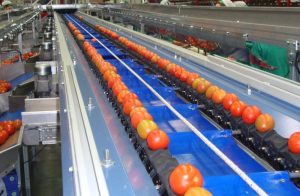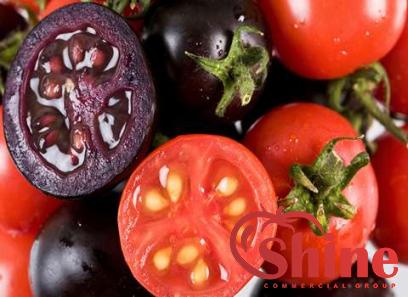You are going to discover everything there is to know about tomato paste right here, in this post. From the raw materials to the processing, and the production equipment required, It is very vital to be familiar with all of the procedures involved in the processing and production of tomato paste if you plan on beginning a business that involves the production or trading of tomato paste. Therefore, by reading this article, you will gain an understanding of the technical process of manufacturing it, which may have implications for the making of it as well as its storage.
We can supply processing equipment for tomatoes, including tomato washers, conveyors, crushers, pasteurizers, evaporators, and filling and packaging machines for pouches and bottles. Tomatoes are processed in numerous ways, the most common of which include canning and drying them out, as well as turning them into a paste, puree, pulp, ketchup, tomato sauce, and tomato juice. Processing tomatoes are picked by a machine when they are fully ripe and red. This helps to retain the maximum flavor.

tomato paste production line
Here is an introduction to the production line of tomato paste. We can deliver comprehensive projects for the production of tomato paste thanks to our sophisticated technology and meticulous craftsmanship. The capacity of the production line for tomato paste ranges from one to two tons per hour in terms of its handling capability.
We can provide on-site installation, commissioning, and training services for you, based on the specifications that you provide. Our tomato processing equipment is the most cost-effective option available due to its sensible design and low overall energy usage.
Advantages of the Tomato Paste Production Line Include:
- Fruit washing machines have a high level of cleanliness, can save both energy and water, and have a performance that is consistent and dependable.
- The roller sorting machine has the capability of having a spraying device, a collection channel, and a waste conveyor developed for it.
- Both the tubular preheater and the tubular sterilizer can have an insulating layer built specifically for them.
- The fruit pulping equipment at the tomato processing factory has a selection of different mesh sizes available for use.
- The Concentrator has a compact design, straightforward construction, and user-friendly operation, cleaning, and upkeep features.

The Process Flow of the Production Line for Tomato Paste is as below:
Fresh Tomato, Tomato Washing, Tomato Sorting, Tomato Breaking, Tomato Pulping, Vacuum Concentration, Paste Sterilization, Finished Tomato Paste.
What steps are involved in the production of tomato paste?
Instructions
- Turn the oven up to 350 degrees Fahrenheit.
- Tomatoes should be cut into quarters.
- Cook the tomatoes at a slow simmer with the olive oil.
- Run the chopped tomatoes through a food processor.
- Spread the pulp out on two separate baking sheets.
- Cook the tomato pulp in the oven until it thickens into a paste.
- Bake until the volume is reduced by more than 50 percent.
- The paste should now be stored in jars.

tomato paste processing equipment
The most important processing equipment at the tomato paste plant is as follows:
- A washing machine of the surfing type
In the tomato washing machine, high-pressure water is used to remove dirt and residue from the fruit. The tomatoes that have been cleaned are transported via scraper elevator to the next step in the process.
- A sorting machine with rollers
Fruits that have been cleaned are fed into the machine through the feeding hopper and then rotate forward in the direction of the outlet. To ensure that the final product is of the highest possible quality, workers remove any tomatoes that do not meet the required standards.
- Broken Pump
Used for transporting tomatoes as well as crushing them to get them ready for preheating and pulping.
- Preheater that uses tubing
A tubular preheater raises the temperature of the pulp by heating it with steam to soften the pulp and deactivate the enzymes. This accomplishes both of these goals.

- Single-channel Pulping Machine
The crushed and preheated tomatoes are fed into a single-channel pulping machine, which then performs an automatic separation of the pulp and residue from the tomatoes. The material that was processed in the previous step is delivered to the machine via the feed inlet, where it begins its journey along the cylinder toward the machine’s outlet.
The material is pulped as a result of the centrifugal force. The pulp is allowed to flow through the sieve and is then sent to the subsequent step, while the skin and seeds are allowed to exit the machine via the residual outlet. This accomplishes the goal of automated separation. You can alter the pace of the pulping process by switching out the sieve and modifying the lead angle of the scraper.
- Boiler for the Concentration of Vacuum
Utilizing a vacuum and operating the device at a low temperature, this apparatus is used to concentrate tomato pulp. When steam is introduced into the jacket located in the bottom portion of the boiler, the material that is currently under vacuum begins to boil and evaporate. The incorporation of a blender into the boiler serves to improve the fluidity of the substance.
- Tubular Sterilizer
The goal of sterilization is accomplished by increasing the temperature of the concentrate within the tubular sterilizer through the use of steam heating.

tomato processing
To know all the steps of processing tomato keep reading the instruction below:
- TRANSPORT AND UNLOADING BY HYDRAULIC
The raw material is automatically dumped into the transport channel in a tomato processing line once the product is received in crates or bins. As an alternative, when loose product is delivered, unloading is done by flooding the bin with water using movable pipes. The tomato is then collected in a separation tank, fed with cleaner water, and outfitted with a chain conveyor to automatically remove stones, mud, and other objects. The product is separated from the water by an inclined grid or roller conveyors. The product is subsequently transported to the production lines at this point.
- SORTING AND WASHING
On roller conveyors, tomatoes can be manually sorted in two stages: the first stage involves an inclined roller conveyor where the product is separated from water, foreign objects, etc. before being washed using a series of sprayers; the second stage involves a horizontal roller conveyor where the tomato rotates on itself to enable accurate operator inspection.
- CUTTING
To maximize the subsequent heat treatment processes, the sorted and rinsed tomatoes must be crushed. The Cold-Break and Hot-Break technical cycles both incorporate the BT60 chopping pump, which ensures a flawless, homogeneous, and fine consistency of the crushed product. Extremely low synaeresis values, in particular for the Hot Break process, can be achieved by using breaking temperatures that are almost 4°C lower than the standard values, a factor that also allows for significant energy savings.
- A Enzyme inactivation (4A) (HOT BREAK)
When making Hot Break tomato paste, the pectins in the juice are preserved, and excellent consistency, color, and synaeresis values are obtained by inactivating the pectolytic enzymes using the Eldorado inactivator.

B- Pre-heating (4B) (COLD BREAK)
To slowly heat the product and maintain the natural tomato flavors and colors that make this type of concentrate unique, tomatoes used to make Cold Break tomato puree are heated in a special tubular unit.
- JUICE EXTRACTION
The heated tomato juice is then delivered to the extraction and refining stage, which is completed in the Giubileo extractor employing the centrifugal separation principle with the aid of movable blades. This procedure can get rid of the fruit’s seeds and peel as well as other undesirable components.
- PRECOGNITIONAL ACTION (OPTIONAL)
The Apollo pre-concentrator, a falling film evaporator with mechanical vapor compression, can be used to send the refined tomato juice to an initial concentration phase, where it will be concentrated between 4.5 and 12° Brix (MVR). Due to its mechanical recompression of acidic vapors, MVR technology enables tomato concentration with up to 98 percent steam savings.
- STERILIZATION AND COOLING
The ideal option for handling big quantities of product and for extended running cycles is the SFC Flash Cooler. By directly injecting cooking steam into the product and cooling it with vacuum expansion, sterilization is accomplished (flash).
As an alternative, the Olimpic TC sterilizer can be used to sterilize and cool tomato paste. Indirect heat exchangers of the concentric tube type with a large capacity, maximum heat exchange efficiency, and process uniformity are used to put the product through a thermal cycle.
- ASEPTIC FILLING
Utilizing aseptic filling heads, the sterilized, cooled product is placed into a variety of sizes of pre-sterilized flexible bags. The high level of automation used by Macropak filling machines and the microprocessor-driven checking system, which continuously monitors all operating parameters, ensure that the packaged product is sterile.

raw materials for tomato paste
The production line for tomato paste results in a highly concentrated product called tomato paste. As its primary source of nutrition, the raw materials are ripe red tomatoes. Crushing, beating, peeling and seeding, canning, and sterilizing are some of the steps involved in its production along the tomato paste assembly line. The finished product resembles a bright red sauce and has the distinctive flavor of tomato throughout its entirety. The production line primarily consists of fresh tomatoes being lifted, cleaned, crushed, pulped, concentrated, and sterilized, among other processes.
- The Raw Materials And Process of Making Tomato Paste:
We must wash, trim, remove any imperfect or unripe fruit, place the tomatoes in the crusher, and then reheat the crushed tomato chunks after they have been crushed. The fresh tomatoes were just recently harvested from the farm. Because the tomato pulp has relatively high water content, we need to vacuum concentrate, sterilize, and finally pack our processed finished product into cans of tomato paste. The heating temperature and cooling time should be selected by the specifications of the finished ketchup.
2. The parameters for the tomato paste-making machine are as follows:
- Fresh tomatoes serve as the raw material.
- The finished product is called tomato sauce.
- Processing capacity: 300 kilograms to three tons of fresh tomatoes per hour
- Ingredients for jam include unadulterated fruit puree, vitamins, sugar, and other flavoring agents.
- Methods of sterilization include pasteurization, ultra-high-temperature sterilization, and high-temperature sterilization using the ultra-high-temperature method. (Adaptable to the specific needs of the situation)
- Aseptic vat packaging, bag-in-box aseptic pouch packaging, tinplate small package packaging, and small bag packaging are all examples of terminal packaging.
- Control method: manual control or automatic control.

tomato paste consistency
There are a variety of methods that may be utilized to evaluate and characterize the consistency rate of tomato paste and tomato puree. A significant amount of work is put out to consistently enhance the consistency of this and other tomato products, specifically to make them thicker or more viscous. The consistency is determined by a large number of factors, some of which are the following: (1) the species of tomato; (2) the sort of “break;” (3) the particle size; and (4) the method of concentration.
With the introduction of the “futures” market for tomato paste, it is necessary to establish a method for measuring the consistency of tomato paste that is planned for delivery by exchange contracts. In addition, a “consistency determination” is being requested by an increasing number of packers and purchasers for their purchases of tomato paste and puree in both packaged and bulk forms.
- OBJECTIVES AND LIMITATIONS
This procedure outlines a method for determining the consistency of tomato paste and/or tomato puree that has a concentration of 12.0 percent or more of natural tomato soluble solids by using, in essence, the Bostwick Consistometer. This method is intended to be used if the tomato paste and/or tomato puree in question has been heated (N.T.S.S.). Additionally, the consistency of tomato puree with an N.T.S.S concentration of less than 12.0 percent can be assessed; in these circumstances, the undiluted puree will be used.

These instructions are to give a standardized approach for determining and reporting the consistency of tomato paste or tomato puree unless a different method is expressly asked to be used. This procedure might be replaced by a different or alternative method, which an applicant might request or specify as a replacement for it. Having said that, the applicant is the one who is responsible for providing the inspector with a copy of the necessary technique.
- FUTURES
The consistency of tomato paste that is provided in the delivery of tomato paste “futures” contracts will be determined by using the approach that is outlined in the following paragraphs.










Your comment submitted.